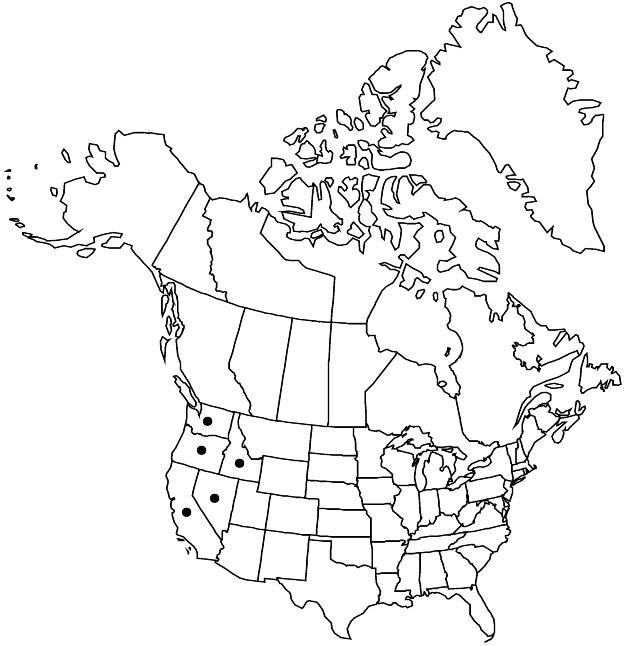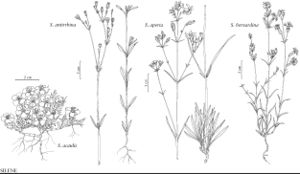Difference between revisions of "Silene bernardina"
Proc. Amer. Acad. Arts 24: 82. 1889.
FNA>Volume Importer |
imported>Volume Importer |
||
| (4 intermediate revisions by one other user not shown) | |||
| Line 8: | Line 8: | ||
}} | }} | ||
|common_names=Palmer’s catchfly | |common_names=Palmer’s catchfly | ||
| + | |special_status={{Treatment/ID/Special_status | ||
| + | |code=F | ||
| + | |label=Illustrated | ||
| + | }} | ||
|basionyms= | |basionyms= | ||
|synonyms={{Treatment/ID/Synonym | |synonyms={{Treatment/ID/Synonym | ||
|name=Silene bernardina subsp. maguirei | |name=Silene bernardina subsp. maguirei | ||
|authority=Bocquet | |authority=Bocquet | ||
| + | |rank=subspecies | ||
}} {{Treatment/ID/Synonym | }} {{Treatment/ID/Synonym | ||
|name=Silene bernardina var. rigidula | |name=Silene bernardina var. rigidula | ||
|authority=(B. L. Robinson) Tiehm | |authority=(B. L. Robinson) Tiehm | ||
| + | |rank=variety | ||
}} {{Treatment/ID/Synonym | }} {{Treatment/ID/Synonym | ||
|name=Silene bernardina var. sierrae | |name=Silene bernardina var. sierrae | ||
|authority=(C. L. Hitchcock & Maguire) Bocquet | |authority=(C. L. Hitchcock & Maguire) Bocquet | ||
| + | |rank=variety | ||
}} {{Treatment/ID/Synonym | }} {{Treatment/ID/Synonym | ||
|name=Silene occidentalis var. nancta | |name=Silene occidentalis var. nancta | ||
|authority=Jepson | |authority=Jepson | ||
| + | |rank=variety | ||
}} {{Treatment/ID/Synonym | }} {{Treatment/ID/Synonym | ||
|name=Silene shockleyi | |name=Silene shockleyi | ||
| − | |authority= | + | |authority= |
| + | |rank=species | ||
}} | }} | ||
|hierarchy=Caryophyllaceae;Caryophyllaceae subfam. Caryophylloideae;Silene;Silene bernardina | |hierarchy=Caryophyllaceae;Caryophyllaceae subfam. Caryophylloideae;Silene;Silene bernardina | ||
| Line 50: | Line 59: | ||
-->{{#Taxon: | -->{{#Taxon: | ||
name=Silene bernardina | name=Silene bernardina | ||
| − | |||
|authority=S. Watson | |authority=S. Watson | ||
|rank=species | |rank=species | ||
| Line 64: | Line 72: | ||
|publication title=Proc. Amer. Acad. Arts | |publication title=Proc. Amer. Acad. Arts | ||
|publication year=1889 | |publication year=1889 | ||
| − | |special status= | + | |special status=Illustrated |
| − | |source xml=https:// | + | |source xml=https://bitbucket.org/aafc-mbb/fna-data-curation/src/2e0870ddd59836b60bcf96646a41e87ea5a5943a/coarse_grained_fna_xml/V5/V5_346.xml |
|subfamily=Caryophyllaceae subfam. Caryophylloideae | |subfamily=Caryophyllaceae subfam. Caryophylloideae | ||
|genus=Silene | |genus=Silene | ||
Latest revision as of 22:10, 5 November 2020
Plants perennial, loosely cespitose; taproot stout; caudex branched, woody, bearing tufts of leaves. Stems not much- branched, slender, (15–)30–60 cm, sparsely pubescent proximally, viscid-glandular distally. Leaves mostly basal; blade linear-lanceolate to oblanceolate, 2–8 cm × 2–6(–15) mm (including petiole), base tapered into slender petiole, apex acute to obtuse, subglabrous to glandular-pubescent on both surfaces; cauline leaves to 4 pairs below inflorescence, narrower than basal leaves, blade usually linear but rarely elliptic-lanceolate. Inflorescences erect, with several short, ascending branches, few-flowered, open, bracteate, shortly pubescent and viscid-glandular; bracts narrowly lanceolate, 3–10 mm, rigid. Flowers: calyx prominently 10-veined, broadly tubular, umbilicate, moderately or not clavate, narrowed around carpophore, lobed, 12–15 × 4–6 mm, thin and papery, with short glandular-viscid pubescence, veins parallel, usually red pigmented, with pale commissures; lobes lanceolate, 2–4 mm, apex acute; petals white, pink, or dingy red, 11/2–2 times calyx, claw equaling calyx, ciliate at base, limb obtriangular, 4–6 mm, deeply divided into 4 linear lobes, appendages 2, conspicuous, laciniate, 2–3 mm, apex rounded; stamens slightly exserted; filaments ciliate at base; styles 3(–4), equaling or longer than stamens. Capsules 1-locular, narrowly ovoid, exceeding calyx, opening by 6 (or 8) ascending teeth; carpophore 3–6 mm. Seeds brown, reniform, 1.5–2 mm broad, shallowly tuberculate on both surfaces, papillate around margins. 2n = 48.
Phenology: Flowering summer.
Habitat: Dry, grassy or gravelly slopes, open woodlands
Elevation: 1300-3600 m
Distribution

Calif., Idaho, Nev., Oreg., Wash., Mexico (Baja California).
Discussion
Silene bernardina is the earliest valid name for this species. Watson had previously (1875) named it S. montana, and that name was taken up by C. L. Hitchcock and B. Maguire (1947), who cited S. bernardina as a subspecies of S. montana. Unfortunately, the epithet montana is pre-occupied in Silene by S. montana Arrondeau (1863), an unrelated European species. The situation was further complicated by Watson in 1877, when he used the name Lychnis montana for another unrelated species now transferred to Silene and called S. hitchguirei.
Silene bernardina varies in leaf width, pubescence, and flower color. The broader-leaved and more sparsely pubescent forms have been referred to subsp. bernardina, and the more-common, narrower-leaved, more-densely pubescent, and viscid forms have been referred to subsp. maguirei.
Some forms of Silene bernardina can be difficult to distinguish from S. verecunda, S. sargentii, and S. oregana. Silene verecunda differs in its smaller, clavate calyx and in its petals being only shortly two-lobed. Silene sargentii is a small, densely cespitose, high-alpine species with very narrow, linear leaves (1–2 mm wide), shortly two-lobed petals, and seeds with much larger papillae around the margins. In S. oregana the petals are larger (two times the calyx) and deeply divided into many very narrow segments; the claw and the filaments are glabrous; the leaves, particularly the basal ones, are broader; and the inflorescences are narrower, with the more numerous flowers arranged on short, ascending branches; also, the calyx lobes are ovate and obtuse instead of lanceolate and acute. The Idaho material tends to be intermediate with S. oregana but has open, dichotomously branched inflorescences, and the petals are nearer to those of S. bernardina. These plants from Valley County in the Payette National Forest need further study, preferably in the field. They may represent a distinct taxon.
Selected References
None.
